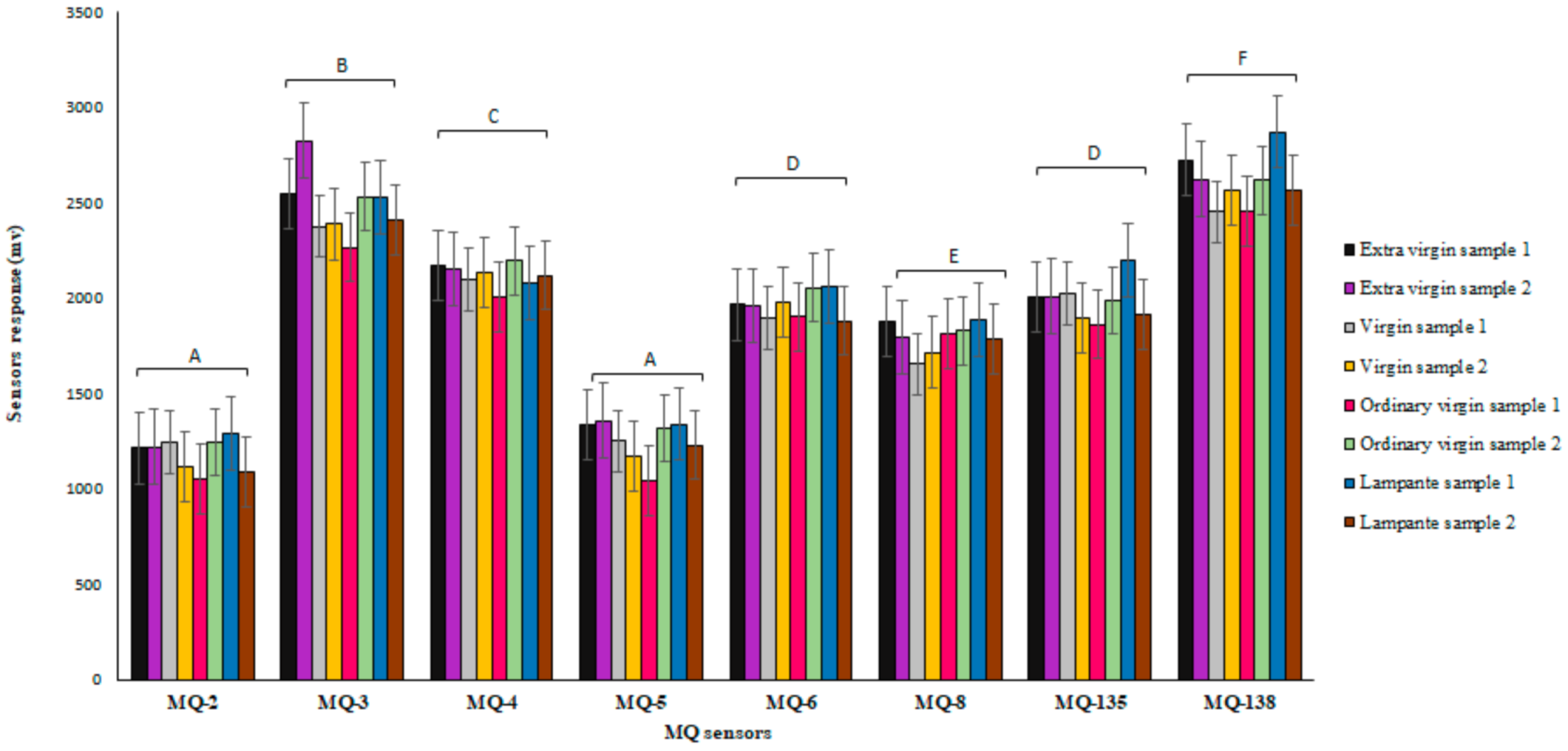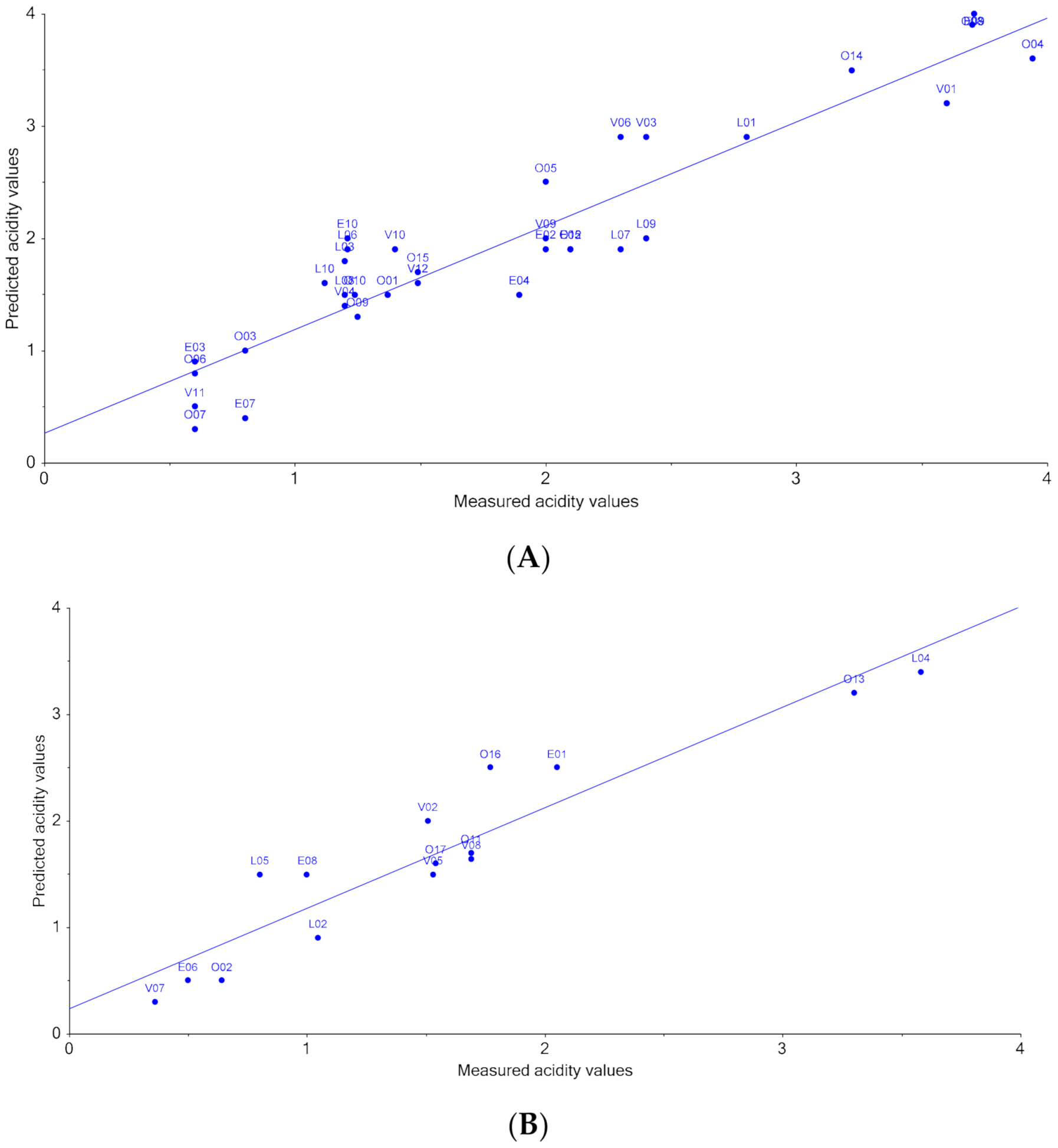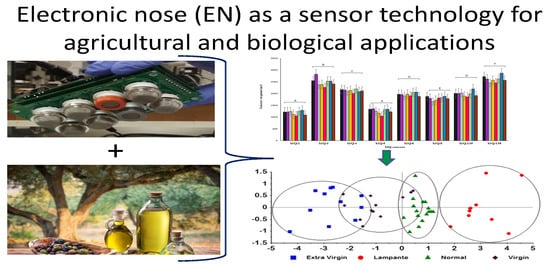Identification and Quantification of Olive Oil Quality Parameters Using an Electronic Nose
Abstract
:1. Introduction
2. Materials and Methods
2.1. Collected Samples
2.2. Chemical Analysis
2.3. Electronic Nose (EN)
2.4. Multivariate Data
2.5. Data Analysis
2.6. Model Performance
3. Results and Discussion
3.1. Sensors Response
3.2. PLS Prediction Models
3.3. PLS-1 Scores Plot
4. Conclusions
Funding
Institutional Review Board Statement
Informed Consent Statement
Data Availability Statement
Acknowledgments
Conflicts of Interest
References
- Passenger Port of Saint-Petersburg, Marine Façade. Available online: https://www.portspb.ru/ (accessed on 11 February 2021).
- Palestinian Central Bureau of Statistics. 2019; Agricultural Survey. Available online: Http://www.pcbs.gov.ps (accessed on 20 April 2021).
- Mailer, R.; Beckingham, C. Testing olive oil quality: Chemical and sensory methods. Profitable & Sustainable Primary Indus-tries. Primefact 2006, 231, 1–5. [Google Scholar]
- Casale, M.; Simonetti, R. Review: Near Infrared Spectroscopy for Analysing Olive Oils. J. Near Infrared Spectrosc. 2014, 22, 59–80. [Google Scholar] [CrossRef]
- Valli, E.; Bendini, A.; Berardinelli, A.; Ragni, L.; Riccò, B.; Grossi, M.; Toschi, T.G. Rapid and innovative instrumental approaches for quality and authenticity of olive oils. Eur. J. Lipid Sci. Technol. 2016, 118, 1601–1619. [Google Scholar] [CrossRef] [Green Version]
- Abu-Khalaf, N.; Hmidat, M. Visible/Near Infrared (VIS/NIR) spectroscopy as an optical sensor for evaluating olive oil quality. Comput. Electron. Agric. 2020, 173, 105445. [Google Scholar] [CrossRef]
- Casson, A.; Beghi, R.; Giovenzana, V.; Fiorindo, I.; Tugnolo, A.; Guidetti, R. Environmental advantages of visible and near infrared spectroscopy for the prediction of intact olive ripeness. Biosyst. Eng. 2020, 189, 1–10. [Google Scholar] [CrossRef]
- Kadiroglu, P.; Korel, F.; Pardo, M. Chemometric analysis of chemo-optical data for the assessment of olive oil blended with hazelnut oil. Riv. Ital. Sostanze Grasse 2019, 96, 123–130. [Google Scholar]
- Hsieh, Y.-C.; Yao, D.-J. Intelligent gas-sensing systems and their applications. J. Micromech. Microeng. 2018, 28, 093001. [Google Scholar] [CrossRef]
- Oates, M.; Madsen, M.; Cuenca Roca, O.; Ruiz-Canales, A. Preliminary results from olive oil classification system using a low cost electronic nose. In III National Symposium of Horticultural Engineering, Dedicated in This Edition to the “Use of Drones and Satellites in Agriculture”; Escola Politecnica Superio: Lugo, Spain, 2018. [Google Scholar]
- Oates, M.J.; Fox, P.; Sanchez-Rodriguez, L.; Carbonell-Barrachina, Á.A.; Ruiz-Canales, A. DFT based classification of olive oil type using a sinusoidally heated, low cost electronic nose. Comput. Electron. Agric. 2018, 155, 348–358. [Google Scholar] [CrossRef]
- Oates, M.; Abu-Khalaf, N.; Molina-Cabrera, C.; Ruiz-Canales, A.; Ramos, J.; Bahder, B. Detection of Lethal Bronzing Disease in Cabbage Palms (Sabal palmetto) Using a Low-Cost Electronic Nose. Biosensors 2020, 10, 188. [Google Scholar] [CrossRef]
- Sanaeifar, A.; ZakiDizaji, H.; Jafari, A.; de la Guardia, M. Early detection of contamination and defect in foodstuffs by electronic nose: A review. TrAC Trends Anal. Chem. 2017, 97, 257–271. [Google Scholar] [CrossRef]
- Abu-Khalaf, N.; Abu Rumaila, B. Electronic tongue and Box-PCR for categorization of different Fusarium strains. Plant Cell Biotechnol. Mol. Biol. 2020, 21, 121–128. [Google Scholar]
- Mudalal, S.; Zaid, A.; Abu-Khalaf, N.; Petracci, M. Predicting the quality traits of white striped turkey breast by visible/near infra-red spectroscopy and multivariate data analysis. Ital. J. Anim. Sci. 2020, 19, 676–686. [Google Scholar] [CrossRef]
- Sayara, T.; Khayat, S.; Saleh, J.; Abu-Khalaf, N.; van der Steen, P. Algal–bacterial symbiosis for nutrients removal from wastewater: The application of multivariate data analysis for process monitoring and control. Environ. Technol. Innov. 2021, 23, 101548. [Google Scholar] [CrossRef]
- Taha, H.; Abu-Khalaf, N. Quality control for herbal medicinal plants using a sensor array (an electronic tongue). In Proceedings of the the 7th International Conference of Biotechnology, Environment and Engineering Sciences, Stockholm, Sweden, 26 June 2020; SRO Media: Stockholm, Sweden, 2020; pp. 25–33. [Google Scholar]
- Cosio, M.S.; Benedetti, S.; Buratti, S.; Scampicchio, M.; Mannino, S. Application of the electronic nose in olive oil analyses. In Olives and Olive Oil in Health and Disease Prevention; Preedy, V.R., Watson, R.R., Eds.; Academic Press: Cambridge, MA, USA, 2010; pp. 553–559. [Google Scholar]
- Berna, A. Metal Oxide Sensors for Electronic Noses and Their Application to Food Analysis. Sensors 2010, 10, 3882–3910. [Google Scholar] [CrossRef] [PubMed] [Green Version]
- Bhandari, M.P.; Carmona, E.N.; Abbatangelo, M.; Sberveglieri, V.; Duina, G.; Malla, R.; Comini, E.; Sberveglieri, G. Discrimina-tion of Quality and Geographical Origin of Extra Virgin Olive Oil by S3 Device with Metal Oxides Gas Sensors. Proceedings 2018, 2, 1061. [Google Scholar] [CrossRef] [Green Version]
- Haddi, Z.; Amari, A.; Ali, A.O.; Bari, N.E.; Barhoumi, H.; Maaref, A.; Jaffrezic-Renault, N.; Bouchikhi, B.E.N.A. Discrimi-nation and identification of geographical origin virgin olive oil by an e-nose based on MOS sensors and pattern recognition techniques. Procedia Eng. 2011, 25, 1137–1140. [Google Scholar] [CrossRef]
- Gliszczyńska-Świgło, A.; Chmielewski, J. Electronic Nose as a Tool for Monitoring the Authenticity of Food. A Review. Food Anal. Methods 2016, 10, 1800–1816. [Google Scholar] [CrossRef] [Green Version]
- Ordukaya, E.; Karlik, B. Quality Control of Olive Oils Using Machine Learning and Electronic Nose. J. Food Qual. 2017, 2017, 9272404. [Google Scholar] [CrossRef] [Green Version]
- Ghasemi-Varnamkhasti, M.; Mohammad-Razdari, A.; Yoosefian, S.H.; Izadi, Z.; Rabiei, G. Selection of an optimized metal oxide semiconductor sensor (MOS) array for freshness characterization of strawberry in polymer packages using response surface method (RSM). Postharvest Biol. Technol. 2019, 151, 53–60. [Google Scholar] [CrossRef]
- Vanstone, N.; Moore, A.; Martos, P.; Neethirajan, S. Detection of the adulteration of extra virgin olive oil by near-infrared spectroscopy and chemometric techniques. Food Qual. Saf. 2018, 2, 189–198. [Google Scholar] [CrossRef] [Green Version]
- Cayuela, J.A. Rapid NIR determination of alkyl esters in virgin olive oil. Grasas y Aceites 2017, 68, 195. [Google Scholar] [CrossRef] [Green Version]
- Karabagias, I.K.; Badeka, A.; Casiello, G.; Longobardi, F.; Kontominas, M.G. Rapid screening of olive oil cultivar differentia-tion based on selected physicochemical parameters, pigment content and fatty acid composition using advanced chemomet-rics. Eur. Food Res. Technol. 2019, 245, 2027–2038. [Google Scholar] [CrossRef]
- Uncu, O.; Ozen, B. Importance of some minor compounds in olive oil authenticity and quality. Trends Food Sci. Technol. 2020, 100, 164–176. [Google Scholar] [CrossRef]
- Beghi, R.; Giovenzana, V.; Tugnolo, A.; Guidetti, R. Application of visible/near infrared spectroscopy to quality control of fresh fruits and vegetables in large-scale mass distribution channels: A preliminary test on carrots and tomatoes. J. Sci. Food Agric. 2018, 98, 2729–2734. [Google Scholar] [CrossRef]
- Escuredo, O.; Seijo-Rodríguez, A.; González-Martín, M.I.; Rodríguez-Flores, M.S.; Seijo, M.C. Potential of near infrared spectroscopy for predicting the physicochemical properties on potato flesh. Microchem. J. 2018, 141, 451–457. [Google Scholar] [CrossRef]
- Porep, J.U.; Kammerer, D.R.; Carle, R. On-line application of near infrared (NIR) spectroscopy in food production. Trends Food Sci. Technol. 2015, 46, 211–230. [Google Scholar] [CrossRef]





| Sensor Name | Target Gas Sensitivity | Typical Detection Ranges (ppm) |
|---|---|---|
| MQ-2 | General combustible gas | 200–5000 liquefied petroleum gas (LPG) and propane, 300–5000 butane, 5000–20,000 methane, 300–5000 hydrogen (H2), 100–2000 Alcohol. |
| MQ-3 | Alcohol vapour | 10–300. |
| MQ-4 | Natural gas and methane | 200–10,000 CH4, natural gas. |
| MQ-5 | LPG, natural gas and coal gas | 200–10,000 LPG, liquefied natural gas (LNG), natural gas, iso-butane, propane and town gas. |
| MQ-6 | LPG, propane | 200–10,000 LPG, iso-butane, propane, LNG. |
| MQ-8 | Hydrogen | 100–10,000. |
| MQ-135 | Air quality control (NH3, benzene, alcohol, smoke) | 10–10,000. |
| MQ-138 | Formaldehyde, benzene, aldehyde, ketone and ester | 10–1000 benzene, 1–1000 alcohol, 10–3000 NH3. |
| PLS-1 Parameters | Acidity |
|---|---|
| Number of PCs used | 2 |
| X variance explained | 86% |
| Y variance explained | 5% |
| R2cal | 0.87 |
| RMSEcal | 0.37 |
| RPDcal | 2.61 |
| REcal | 17% |
| Slopecal | 0.92 |
| R2val | 0.88 |
| RMSEval | 0.35 |
| RPDval | 2.68 |
| REval | 18% |
| Slopeval | 0.94 |
Publisher’s Note: MDPI stays neutral with regard to jurisdictional claims in published maps and institutional affiliations. |
© 2021 by the author. Licensee MDPI, Basel, Switzerland. This article is an open access article distributed under the terms and conditions of the Creative Commons Attribution (CC BY) license (https://creativecommons.org/licenses/by/4.0/).
Share and Cite
Abu-Khalaf, N. Identification and Quantification of Olive Oil Quality Parameters Using an Electronic Nose. Agriculture 2021, 11, 674. https://doi.org/10.3390/agriculture11070674
Abu-Khalaf N. Identification and Quantification of Olive Oil Quality Parameters Using an Electronic Nose. Agriculture. 2021; 11(7):674. https://doi.org/10.3390/agriculture11070674
Chicago/Turabian StyleAbu-Khalaf, Nawaf. 2021. "Identification and Quantification of Olive Oil Quality Parameters Using an Electronic Nose" Agriculture 11, no. 7: 674. https://doi.org/10.3390/agriculture11070674
APA StyleAbu-Khalaf, N. (2021). Identification and Quantification of Olive Oil Quality Parameters Using an Electronic Nose. Agriculture, 11(7), 674. https://doi.org/10.3390/agriculture11070674







